
Card Type Guide
Not sure what type of time card you need for payroll to run smoothly? We made a guide for you to learn about which time card would be perfect for your system!
Pay Periods
The most common pay period frequencies are semi-monthly, monthly, biweekly, weekly. Each card has one or more pay periods that it works with. Different pay schedules have their own advantages and disadvantages, so let’s take a look at the differences below to help find the right time card for your business:
Semi-Monthly:
Semi-monthly and bi-weekly pay periods are very similar, but each have their pros and cons. A semi-monthly payroll occurs twice each month on specific dates, such as the 15th and 30th. They both involve employees getting paid twice a month, but there are two extra checks for biweekly (26) versus semi-monthly (24). Your accountant runs monthly reports, not weekly reports, which is why your accounting department may prefer semi-monthly pay periods since the last paycheck of the month will typically coincide with the end of the month. Employees' benefits also typically run on a monthly basis. Deductions and expenses are much easier to calculate on semi-monthly or monthly pay periods. If you are paying your employees biweekly, however, you will have to manage deductions based on the total number of annual pay periods (26).
Bi-Weekly:
Bi-weekly pay periods are very similar to semi-monthly pay periods. A bi-weekly payroll occurs every other week, such as every other Friday. Since there are 52 weeks in a year, bi-weekly pay periods have two months out of the year will have three pay periods instead of two. So who prefers biweekly pay periods? Hourly employees that can collect overtime hours prefer bi-weekly pay periods because they may have inconsistent weekly work schedules, which can include overtime. For example, your employee may work 60 hours one week, and with a a biweekly pay schedule, this overtime is easy to calculate. It is more complicated for companies on a semi-monthly pay period because they typically pay their hourly employees at 86.67 hours per period (which is a little over two 40-hour weeks). If those extra hours are between two different semi-monthly pay periods, you will have to make adjustments and it can be confusing.
Monthly:
Monthly pay periods are not a popular option for employees, and usually benefit the company more than other pay options. A monthly pay period offers similar benefits that a semi-monthly pay period offers because calculations, deductions, and accruals are done at the end of each month for each paycheck (12 per year). Companies choose this option because they only have to run payroll once a month, lowering their payroll costs. It is also simpler for employers to manage; employees know they will receive one paycheck per month and 12 per year, which helps everybody involved avoid confusion. The reason employees do not like monthly pay periods is because their paycheck frequency is so low. It can put a financial strain on employees, as they only get paid once per month. It is especially not suitable for hourly workers because monthly payroll least reflects the compensation that worker has earned. For example, if your employee works 60 hours one week and 20 hours the next, monthly payroll would still just pay they employee in a large chunk at the end of the month.
Weekly:
Weekly payroll is not a popular option for most companies because one of the most prohibitive reasons is cost. Most payroll vendors charge each time payroll is run. If you have multiple workers on weekly schedules, those fees can add up quickly. Another downside of the weekly payroll system is that every time you run payroll, your payroll administrator hours start to add up, especially with a lot of employees and if there are payroll accruals and overtime. But weekly payroll is an option that hourly employees like. Weekly payroll better mirrors an hourly employee’s cash flow needs. If an hourly employee has an irregular working schedule with overtime, weekly payroll best reflects the compensation that worker has earned. For example, if your employee works 60 hours one week and 20 hours the next, weekly payroll makes sure your employee is paid that valuable overtime in the first week when she may need it most. Even salaried employees may appreciate getting paid more often.
For a simple run-down on which pay period system is best for your company, check out this guide:
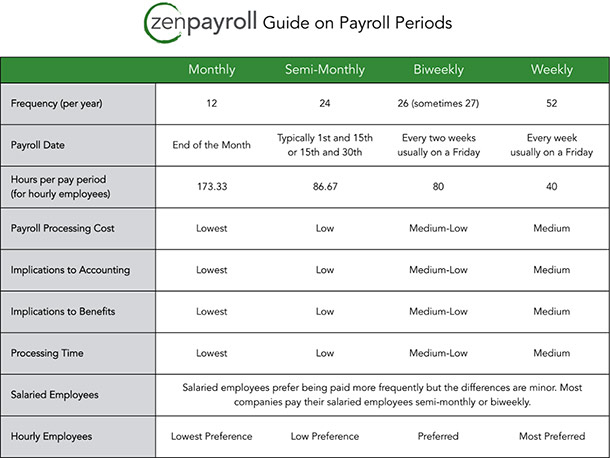
Loading Style
Time cards are designed to work with a top loading time clock and/or a front loading time clock. If you want to learn more about which loading style would best fit your operation, we highlighted the pros and cons of each style below:
Top Loading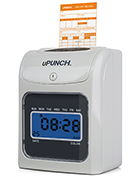
Top loading time clocks automatically feed and print on the correct line of the time card. They also can have the ability to calculate hours worked for employees, including overtime. Top loading time clocks feature a synchronized time display so workers know exactly what time their card will be punched. These features make them easier, faster and more accurate than side-printing time recorders.
The disadvantage of top loading time clocks is that although they are accurate, you have to set up pay period and calculation settings so that the clock will punch on the correct line of the time card. You also have to buy specific time cards to match the pay period settings of the time clock.
Front Loading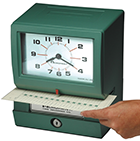
Front loading time clocks are designed to stamp at a manual location on the time card. They are simple to program and are designed to versatile. They are both an employee time clock and a document time stamp wrapped in one. Front loading clocks are simple, easy to use and durable.
The main drawback of front loading time clocks is that they cannot calculate hours for employees. There is also room for error when using the clock, because the user chooses where on the card the clock will punch. Some operations like court offices find this feature useful because they can easily and efficiently stamp court documents , which they would not be able to do with a top loading clock.
Single Sided Cards vs. Double Sided Cards
Most time cards have a single sided or double sided option. If you are not sure what style would work best for your operation, we highlighted the pros and cons of each below:
Single Sided Time Cards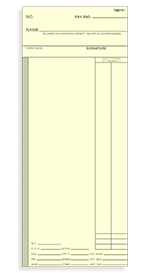
Single sided time cards are used to keep things simple at a workplace. When there are a lot of employees at an operation, mistakes are prone to happen. Single sided time cards keep all the data one one side of the card so cards won't be punched on the wrong side or data won't be read incorrectly. They are also easier to store in a time card rack when the data is only on the front of the card.
The downside to single sided time cards is that companies will go through time cards faster than double sided time cards. Double sided time cards are an easy way to keep extra expenses low.
Double Sided Time Cards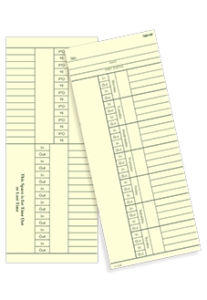
Double sided time cards are more efficient at collecting data than single sided time cards. Some double sided time cards offer an extra work period on the back, while others have fields on the back to help you collect overtime hours, deductions, expenses, ect. Using double sided time cards help keep your extra business expenses low because you are buying less time cards overall.
The downside of double sided time cards is that employees can get confused at where they should punch on the card, and mistakes can happen. The sides should be clearly marked with the date/pay period.
